 W
WIn sound recording and reproduction, audio mixing is the process of optimizing and combining multitrack recordings into a final mono, stereo or surround sound product. In the process of combining the separate tracks, their relative levels are adjusted and balanced and various processes such as equalization and compression are commonly applied to individual tracks, groups of tracks, and the overall mix. In stereo and surround sound mixing, the placement of the tracks within the stereo field are adjusted and balanced. Audio mixing techniques and approaches vary widely and have a significant influence on the final product.
 W
WAn automixer, or automatic microphone mixer, is a live sound mixing device that automatically reduces the strength of a microphone's audio signal when it is not being used. Automixers lower the hiss, rumble, reverberation and other extraneous noise that occur when several microphones operate simultaneously.
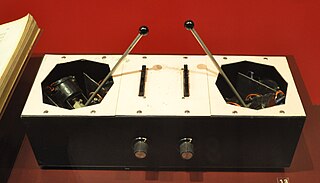 W
WThe Azimuth Co-ordinator was the first panning control for a quadraphonic sound system, at that time a new concept. Pink Floyd became the first band to use it in their early shows.
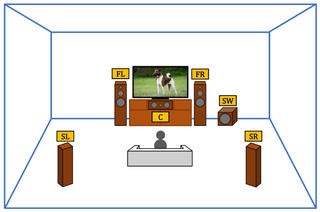 W
WThe fundamental principle of bass management in surround sound replay systems is that bass content in the incoming signal, irrespective of channel, should be directed only to loudspeakers capable of reproducing it, whether the latter are the main system loudspeakers or one or more special low-frequency speakers (subwoofers). There are notation differences between the pre-bass-managed signal and after it has passed through the bass manager. For example, when using 5.1 surround sound:
 W
WBBC Research & Development is the technical research department of the BBC.
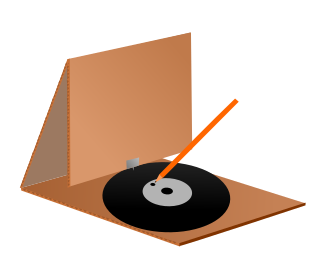 W
WCardTalk is an inexpensive cardboard phonograph for playing recordings, mainly voice, made on vinyl records. The name was used by Global recordings network, a Christian missionary movement which used the device from the 1960s to play religious talks in remote parts of the world that did not have electricity. It consists of a flat piece of cardboard creased and folded into a triangle. The base has a nub to hold the record in place. The upper "arm" forms the "pointy" part of the triangle and has a needle which is placed upon the record. The record is spun using a small pointed object like a pencil. The cardboard picks up the impressions on the record and vibrates loud enough to be heard causing the "Card" to "Talk". Several cardboard phonograph playing devices were patented around the same period and these include Jauquet (1953) for a "Pocket Speaking Device", J.S. Wiener's "Sound Emitting Device" (1967) and the "Record Player" of Max Meier-Maletz (1972).
 W
WClipping is a form of waveform distortion that occurs when an amplifier is overdriven and attempts to deliver an output voltage or current beyond its maximum capability. Driving an amplifier into clipping may cause it to output power in excess of its power rating.
 W
WCompatible Discrete 4, also known as Quadradisc or CD-4 was as a discrete four-channel quadraphonic system for phonograph records. The system was created by JVC and RCA in 1971 and introduced in May 1972. Many recordings using this technology were released on LP during the 1970s.
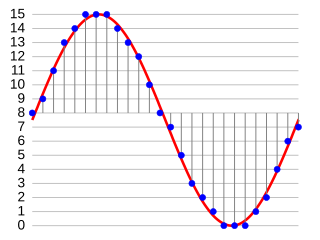 W
WA content format is an encoded format for converting a specific type of data to displayable information. Content formats are used in recording and transmission to prepare data for observation or interpretation. This includes both analog and digitized content. Content formats may be recorded and read by either natural or manufactured tools and mechanisms.
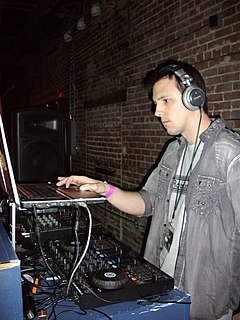 W
WControllerism is the art and practice of using musical software controllers, e.g. MIDI, Open Sound Control (OSC), joystick, etc., to build upon, mix, scratch, remix, effect, modify, or otherwise create music, usually by a Digital DJ or Live PA performer, often called a "controllerist". Controllerism is also a nod to traditional musicianship and instrumental-ism paired with modern computer sequencing software such as Ableton Live and Native Instruments Traktor. However a working knowledge of scales and chords is not necessarily required as the performers typically focus their efforts more on sequencing events, software effect and instrument manipulations using buttons, knobs, faders, keys, foot switches and pedals than on instrumental notes played in real time. With recent developments in music technology, particularly in software instruments, a USB MIDI controller enables musicians almost unlimited possibilities to control a wide variety of sound types.
 W
WData storage is the recording (storing) of information (data) in a storage medium. DNA and RNA, handwriting, phonographic recording, magnetic tape, and optical discs are all examples of storage media. Recording may be accomplished with virtually any form of energy. Electronic data storage requires electrical power to store and retrieve data.
 W
WA digital audio workstation (DAW) is an electronic device or application software used for recording, editing and producing audio files. DAWs come in a wide variety of configurations from a single software program on a laptop, to an integrated stand-alone unit, all the way to a highly complex configuration of numerous components controlled by a central computer. Regardless of configuration, modern DAWs have a central interface that allows the user to alter and mix multiple recordings and tracks into a final produced piece.
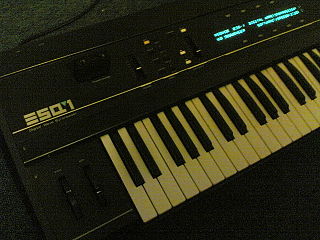 W
WEnsoniq ESQ-1 is a 61-key, velocity sensitive, eight-note polyphonic and multitimbral synthesizer released by Ensoniq in 1985. It was marketed as a "digital wave synthesizer" but was an early Music Workstation. Although its voice generation is typically subtractive in much the same fashion as most analog synthesizers that preceded it, its oscillators are neither voltage nor "digitally controlled", but true digital oscillators, provided by a custom Ensoniq wavetable chip. The signal path includes analog resonant low-pass filters and an analog amplifier.
 W
WFoley is the reproduction of everyday sound effects that are added to films, videos, and other media in post-production to enhance audio quality. These reproduced sounds, named after sound-effects artist Jack Foley, can be anything from the swishing of clothing and footsteps to squeaky doors and breaking glass. Foley sounds are used to enhance the auditory experience of the movie. Foley can also be used to cover up unwanted sounds captured on the set of a movie during filming, such as overflying airplanes or passing traffic.
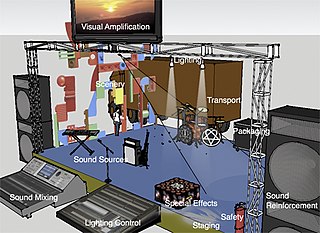 W
WLive performance events including theater, music, dance, opera, use production equipment and services such as staging, scenery, mechanicals, sound, lighting, video, special effects, transport, packaging, communications, costume and makeup. They all share the same goal: to convince live audience members that there is no better place that they could be at the moment. This is achieved through establishing a bond between performer and audience. Live performance events tend to use visual scenery, lighting, costume amplification and a shorter history of visual projection and sound amplification reinforcement.
 W
WLive sound mixing is the blending of multiple sound sources by an audio engineer using a mixing console or software. Sounds that are mixed include those from instruments and voices which are picked up by microphones and pre-recorded material, such as songs on CD or a digital audio player. Individual sources are typically equalised to adjust the bass and treble response and routed to effect processors to ultimately be amplified and reproduced via a loudspeaker system. The live sound engineer listens and balances the various audio sources in a way that best suits the needs of the event.
 W
WMultichannel Audio Digital Interface (MADI) or AES10 is an Audio Engineering Society (AES) standard that defines the data format and electrical characteristics of an interface that carries multiple channels of digital audio. The AES first documented the MADI standard in AES10-1991, and updated it in AES10-2003 and AES10-2008. The MADI standard includes a bit-level description and has features in common with the two-channel AES3 interface.
 W
WA matrix mixer is an audio electronics device that routes multiple input audio signals to multiple outputs. It usually employs level controls such as potentiometers to determine how much of each input is going to each output, and it can incorporate simple on/off assignment buttons. The number of individual controls is at least the number of inputs multiplied by the number of outputs.
 W
WThe MC-2300 is a solid-state power amplifier which was built by the American high-end audio company McIntosh, and sold between the years 1971 and 1980. It can be utilized either as a 300-watt-per-channel stereo amp, or a 600-watt monoblock, and was rated by its manufacturer as being able to produce this amount of power continuously, with very little distortion. McIntosh's ratings were conservative, however, because like many of their amplifiers, when bench-tested the MC-2300 has frequently been found to produce an even higher level of clean power.
 W
WIn sound recording and reproduction, and sound reinforcement systems, a mixing console is an electronic device for combining sounds of many different audio signals. Inputs to the console include microphones being used by singers and for picking up acoustic instruments, signals from electric or electronic instruments, or recorded music. Depending on the type, a mixer is able to control analog or digital signals. The modified signals are summed to produce the combined output signals, which can then be broadcast, amplified through a sound reinforcement system or recorded.
 W
WA mixtape is a compilation of music, typically from multiple sources, recorded onto a medium. With origins in the 1980s, the term normally describes a homemade compilation of music onto a cassette tape, CD, or digital playlist. The songs are either ordered sequentially or made into a continuous program by beatmatching the songs and creating seamless transitions at their beginnings and endings with fades or abrupt edits. Essayist Geoffrey O'Brien described this definition of the mixtape as "perhaps the most widely practiced American art form".
 W
WMatthew Edwin Moldover, known as Moldover, is a musician and instrument designer based in San Francisco, CA. The MIDI Manufacturers Association has referred to him as the "Godfather of Controllerism". He is known for his fusion of music and technology which he synthesizes through a variety of inventions including the Mojo, Robocaster, Octamasher and Guitar Wing.
 W
WA music store or musical instrument store is a retail business that sells musical instruments and related equipment and accessories. Some music stores provide additional services for a fee, such as music lessons, instrument or equipment rental, or repair services.
 W
WNHK Science & Technical Research Laboratories, headquartered in Setagaya, Tokyo, Japan, is responsible for technical research at NHK, Japan's public broadcaster.
 W
WOctophonic sound is a form of audio reproduction that presents eight discrete audio channels using eight speakers. For playback, the speakers may be positioned in a circle around the listeners or in any other configuration.
 W
WA peak programme meter (PPM) is an instrument used in professional audio that indicates the level of an audio signal.
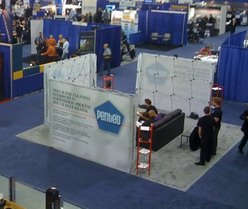 W
WPenteo Surround, Inc. (Penteo) is a digital audio software vendor that markets ADL’s Penteo plug-ins for stereo-to-5.1 and stereo to 7.1 surround upmixing. As an up-mixer, Penteo transforms any stereo recording, soundtrack, DJ mix or live television broadcast into surround sound. Penteo claims that its technology results in a more natural and more precise sounding surround experience without generating any artificial & unwanted sounds, and only Penteo is 100% ITU down-mix compatible back to the original stereo track.
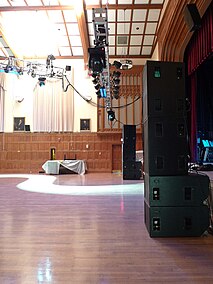 W
WA professional audio store is a retail business that sells, and in many cases rents, sound reinforcement system equipment and PA system components used in music concerts, live shows, dance parties and speaking events. This equipment typically includes microphones, power amplifiers, electronic effects units, speaker enclosures, monitor speakers, subwoofers and audio consoles (mixers). Some professional audio stores also sell sound recording equipment, DJ equipment, lighting equipment used in nightclubs and concerts and video equipment used in events, such as video projectors and screens. Some professional audio stores rent "backline" equipment used in rock and pop shows, such as stage pianos and bass amplifiers. While professional audio stores typically focus on selling new merchandise, some stores also sell used equipment, which is often the equipment that the company has previously rented out for shows and events.
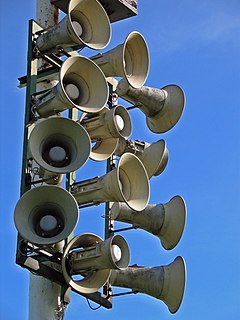 W
WA public address system is an electronic system comprising microphones, amplifiers, loudspeakers, and related equipment. It increases the apparent volume (loudness) of a human voice, musical instrument, or other acoustic sound source or recorded sound or music. PA systems are used in any public venue that requires that an announcer, performer, etc. be sufficiently audible at a distance or over a large area. Typical applications include sports stadiums, public transportation vehicles and facilities, and live or recorded music venues and events. A PA system may include multiple microphones or other sound sources, a mixing console to combine and modify multiple sources, and multiple amplifiers and loudspeakers for louder volume or wider distribution.
 W
WQuadraphonic Sound was a matrix 4-channel quadraphonic sound system for phonograph records. The system was based on technology created by Peter Scheiber, but further developed by engineer Ryosuke Ito of Sansui in the early 1970s.
 W
WQSound is the original name for a positional three-dimensional (3D) sound processing algorithm from QSound Labs that creates 3D audio effects from multiple monophonic sources and sums the outputs to two channels for presentation over regular stereo speakers. QSound was eventually re-dubbed "Q1" after the introduction of "Q2", a positional 3D algorithm for headphones. Later multi-speaker surround system support was added to the positional 3D process, the QSound positional 3D audio process became known simply as "Q3D". QSound was founded by Larry Ryckman (CEO), Danny Lowe and John Lees. Jimmy Iovine served as SVP of Music and Shelly Yakus as VP of Audio Engineering in its formative years.
 W
WQuadraphonic open reel tape or Q4 was the first medium for quadraphonic sound recording and playback, introduced to the American market by the Vanguard Recording Society in June 1969.
 W
WQuadraphonic sound – equivalent to what is now called 4.0 surround sound – uses four audio channels in which speakers are positioned at the four corners of a listening space. The system allows for the reproduction of sound signals that are independent of one another.
 W
WSound recording and reproduction is an electrical, mechanical, electronic, or digital inscription and re-creation of sound waves, such as spoken voice, singing, instrumental music, or sound effects. The two main classes of sound recording technology are analog recording and digital recording.
 W
WRemote recording, also known as location recording, is the act of making a high-quality complex audio recording of a live concert performance, or any other location recording that uses multitrack recording techniques outside of a recording studio. The multitrack recording is then carefully mixed, and the finished result is called a remote recording or a live album. This is in contrast to a field recording which uses few microphones, recorded onto the same number of channels as the intended product. Remote recording is not the same as remote broadcast for which multiple microphones are mixed live and broadcast during the performance, typically to stereo. Remote recording and remote broadcast may be carried out simultaneously by the same crew using the same microphones.
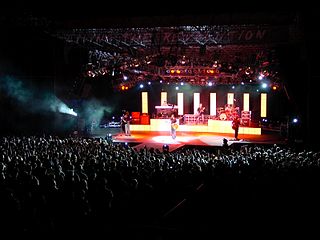 W
WA sound reinforcement system is the combination of microphones, signal processors, amplifiers, and loudspeakers in enclosures all controlled by a mixing console that makes live or pre-recorded sounds louder and may also distribute those sounds to a larger or more distant audience. In many situations, a sound reinforcement system is also used to enhance or alter the sound of the sources on the stage, typically by using electronic effects, such as reverb, as opposed to simply amplifying the sources unaltered.
 W
WA sound truck is a vehicle equipped with a public address system and loudspeakers, typically used to play recorded messages at high volume to the public while driving through residential areas. They are used in many countries by groups to disseminate political messages, such as by candidates during election campaigns, and in some countries for commercial advertising and promotion. They are also used by public safety authorities during emergencies, such as evacuations, to get information quickly to local populations. The use of sound trucks for advertising is illegal in many jurisdictions. It is legal in Portugal and usually used during election campaigns by political parties. It is also legal in Japan. For the legal situation in the United States see Saia v. New York (1948) and Kovacs v. Cooper (1949). In Bagé, Rio Grande do Sul, Brazil, the level of the sound cannot exceed 65 decibels.
 W
WA speaker terminal is a type of electrical connector often used for interconnecting speakers and audio power amplifiers.
 W
WSQ Quadraphonic was a matrix 4-channel quadraphonic sound system for vinyl LP records. It was introduced by CBS Records in 1971. Many recordings using this technology were released on LP during the 1970s.
 W
WAn audio tape recorder, tape deck, or tape machine is a sound recording and reproduction device that records and plays back sounds usually using magnetic tape for storage. In its present-day form, it records a fluctuating signal by moving the tape across a tape head that polarizes the magnetic domains in the tape in proportion to the audio signal. Tape-recording devices include the reel-to-reel tape deck and the cassette deck, which uses a cassette for storage.
 W
WA tape transport is the collection of parts of a magnetic tape player or recorder that move the tape and play or record it. Transport parts include the head, capstan, pinch roller, tape pins, and tape guide. The tape transport as a whole is called the transport mechanism.
 W
WA telegraph sounder is an antique electromechanical device used as a receiver on electrical telegraph lines during the 19th century. It was invented by Alfred Vail after 1850 to replace the previous receiving device, the cumbersome Morse register and was the first practical application of the electromagnet. When a telegraph message comes in it produces an audible "clicking" sound representing the short and long keypresses – "dots" and "dashes" – which are used to represent text characters in Morse code. A telegraph operator would translate the sounds into characters representing the telegraph message.
 W
WVehicle audio is equipment installed in a car or other vehicle to provide in-car entertainment and information for the vehicle occupants. Until the 1950s it consisted of a simple AM radio. Additions since then have included FM radio (1952), 8-track tape players, cassette players, record players, CD players (1984), DVD players, Blu-ray players, navigation systems, Bluetooth telephone integration, and smartphone controllers like CarPlay and Android Auto. Once controlled from the dashboard with a few buttons, they can now be controlled by steering wheel controls and voice commands.
 W
WThe Volta Laboratory and the Volta Bureau were created in Georgetown, Washington, D.C. by Alexander Graham Bell.
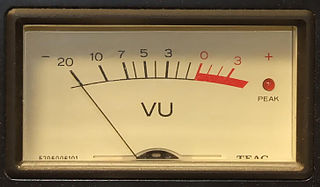 W
WA volume unit (VU) meter or standard volume indicator (SVI) is a device displaying a representation of the signal level in audio equipment. The original design was proposed in the 1940 IRE paper, A New Standard Volume Indicator and Reference Level, written by experts from CBS, NBC, and Bell Telephone Laboratories. The Acoustical Society of America then standardized it in 1942 for use in telephone installation and radio broadcast stations. Consumer audio equipment often features VU meters, both for utility purposes and for aesthetics.
 W
WA walkstation is an electronic music device which provides musicians with the facilities of a music workstation in a portable package. The term was introduced as part of the marketing for the Yamaha QY10, presumably as a portmanteau of Walkman and workstation. Its usage is typically limited to the portable members of Yamaha's QY sequencer family.
 W
WThe Wall of Sound was an enormous public address system designed specifically for the Grateful Dead's live performances in 1974. It was the creation of audio engineer Owsley "Bear" Stanley. The Wall of Sound fulfilled Owsley's desire for a distortion-free sound system that could also serve as its own monitoring system. The Wall of Sound was the largest concert sound system built at that time.
 W
WWave field synthesis (WFS) is a spatial audio rendering technique, characterized by creation of virtual acoustic environments. It produces artificial wavefronts synthesized by a large number of individually driven loudspeakers. Such wavefronts seem to originate from a virtual starting point, the virtual source or notional source. Contrary to traditional spatialization techniques such as stereo or surround sound, the localization of virtual sources in WFS does not depend on or change with the listener's position.